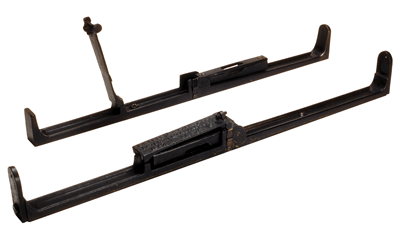American Levels and Their Makers
O. Hanks Patent, by M. Watkins & Son, Bristol, Connecticut
 An
element of mystery surrounds the "O. Hanks Patent" level. Although the level
in the foreground is marked as being patented by Oscar Hanks in 1847, no such
patent has been found. It is possible that Hanks obtained a patent prior to
1836 and its was lost in the Patent Office fire of that year. It is also possible
that Hanks drew a sketch or showed the Watkins a model and they assumed that
he had obtained a patent. A patent was granted 36 years later to two New York
gentlemen named Ward and Burton. Their level was extremely similar to the levels
shown here, contained no new features, and lacked both the adjustable endpieces
of the front level and a cover the vial container (casket).
An
element of mystery surrounds the "O. Hanks Patent" level. Although the level
in the foreground is marked as being patented by Oscar Hanks in 1847, no such
patent has been found. It is possible that Hanks obtained a patent prior to
1836 and its was lost in the Patent Office fire of that year. It is also possible
that Hanks drew a sketch or showed the Watkins a model and they assumed that
he had obtained a patent. A patent was granted 36 years later to two New York
gentlemen named Ward and Burton. Their level was extremely similar to the levels
shown here, contained no new features, and lacked both the adjustable endpieces
of the front level and a cover the vial container (casket).
The levels feature a single vial, hinged on the right hand side. As shown on
the uppermost level, the top piece of the level opens to reveal the upside down
vial casket. The casket vial is then pivoted 180 degrees and lies flat in the
channel to act as a level. The top piece could be closed with the cartridge
in external position and the casket rotated back 90 degrees to make plumb measurements.
The top has an adjustment screw on the right hand side to adjust the plumb measurement,
and there is also a screw through the bottom rail beneath the external position
of the cartridge to adjust the level measurement. The top piece has ears on
the right side, one of which fits behind a brass leaf spring on the base to
clamp the top in a closed position. The careful observer will note an iron piece
containing a peep hole attached to each end of the base of the front level.
These pieces were slotted and were adjustable vertically.
The top level is similar in most respects to the front level except for the
absence of the signature cast into the top piece and the lack of adjustable
sights. The only marking is "1839" stamped into the side of the level. The front
level is 21 _" long while the top level is 19 ½" long and much more crudely
made. It seems possible that the top level was made in the Albany, New York
area because that is where Hanks was located in the 1830s.
The Watkins version of the level has yellow striping over black japanning and
the remnants of it are observable on the sides of the base. The top of the vial
casket has much more yellow decoration and is visible when the top is in the
open position as in the upper most level.

Copyright 1999 01 Inc., NYC
 An
element of mystery surrounds the "O. Hanks Patent" level. Although the level
in the foreground is marked as being patented by Oscar Hanks in 1847, no such
patent has been found. It is possible that Hanks obtained a patent prior to
1836 and its was lost in the Patent Office fire of that year. It is also possible
that Hanks drew a sketch or showed the Watkins a model and they assumed that
he had obtained a patent. A patent was granted 36 years later to two New York
gentlemen named Ward and Burton. Their level was extremely similar to the levels
shown here, contained no new features, and lacked both the adjustable endpieces
of the front level and a cover the vial container (casket).
An
element of mystery surrounds the "O. Hanks Patent" level. Although the level
in the foreground is marked as being patented by Oscar Hanks in 1847, no such
patent has been found. It is possible that Hanks obtained a patent prior to
1836 and its was lost in the Patent Office fire of that year. It is also possible
that Hanks drew a sketch or showed the Watkins a model and they assumed that
he had obtained a patent. A patent was granted 36 years later to two New York
gentlemen named Ward and Burton. Their level was extremely similar to the levels
shown here, contained no new features, and lacked both the adjustable endpieces
of the front level and a cover the vial container (casket).